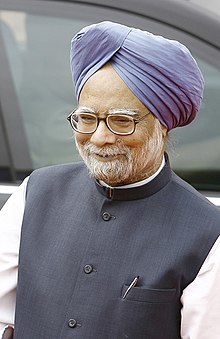The economic liberalisation in India refers to ongoing reforms in India that started in 1991. After Independence in 1947, India adhered to socialist policies. In the 1980s, Prime Minister Rajiv Gandhi initiated some reforms. In 1991, after the International Monetary Fund (IMF) had bailed out the bankrupt state, the government of P. V. Narasimha Rao and his finance minister Manmohan Singh started breakthrough reforms.[1] The new policies included opening for international trade and investment, deregulation, initiation of privatization, tax reforms, and inflation-controlling measures. The overall direction of liberalisation has since remained the same, irrespective of the ruling party, although no party has yet tried to take on powerful lobbies such as the trade unions and farmers, or contentious issues such as reforming labor laws and reducing agricultural subsidies.[2]
As of 2009, about 300 million people—equivalent to the entire population of the United States—have escaped extreme poverty.[3] The fruits of liberalisation reached their peak in 2007, when India recorded its highest GDP growth rate of 9%.[4] With this, India became the second fastest growing major economy in the world, next only to China.[5] An Organisation for Economic Co-operation and Development(OECD) report states that the average growth rate 7.5% will double the average income in a decade, and more reforms would speed up the pace.[6]
Indian government coalitions have been advised to continue liberalisation. India grows at slower pace than China, which has beenliberalising its economy since 1978.[7] McKinsey states that removing main obstacles "would free India’s economy to grow as fast as China’s, at 10 percent a year"Indian economic policy after independence was influenced by the colonial experience (which was seen by Indian leaders as exploitative in nature) and by those leaders' exposure to Fabian socialism. Policy tended towards protectionism, with a strong emphasis on import substitution, industrialization, state intervention in labor and financial markets, a large public sector, business regulation, and central planning.[9] Five-Year Plans of India resembled central planning in the Soviet Union. Steel, mining, machine tools, water,telecommunications, insurance, and electrical plants, among other industries, were effectively nationalized in the mid-1950s.[10]Elaborate licences, regulations and the accompanying red tape, commonly referred to as Licence Raj, were required to set up business in India between 1947 and 1990.[11]
Before the process of reform began in 1991, the government attempted to close the Indian economy to the outside world. The Indian currency, the rupee, was inconvertible and high tariffs and import licensing prevented foreign goods reaching the market. India also operated a system of central planning for the economy, in which firms required licenses to invest and develop. The labyrinthine bureaucracy often led to absurd restrictions—up to 80 agencies had to be satisfied before a firm could be granted a licence to produce and the state would decide what was produced, how much, at what price and what sources of capital were used. The government also prevented firms from laying off workers or closing factories. The central pillar of the policy was import substitution, the belief that India needed to rely on internal markets for development, not international trade—a belief generated by a mixture of socialism and the experience of colonial exploitation. Planning and the state, rather than markets, would determine how much investment was needed in which sectors.
In the 80s, the government led by Rajiv Gandhi started light reforms. The government slightly reduced License Raj and also promoted the growth of the telecommunications and software industries.[citation needed]
The Vishwanath Pratap Singh government (1989–1990) and Chandra Shekhar government (1990–1991) did not add any significant reforms.
[edit]Impact
- The low annual growth rate of the economy of India before 1980, which stagnated around 3.5% from 1950s to 1980s, while per capita income averaged 1.3%.[13] At the same time, Pakistan grew by 5%, Indonesia by 9%, Thailand by 9%, South Korea by 10% and inTaiwan by 12%.[14]
- Only four or five licences would be given for steel, power and communications. License owners built up huge powerful empires.[12]
- A huge public sector emerged. State-owned enterprises made large losses.[12]
- Infrastructure investment was poor because of the public sector monopoly.[12]
- License Raj established the "irresponsible, self-perpetuating bureaucracy that still exists throughout much of the country"[15] andcorruption flourished under this system[5].
[edit]Narasimha Rao government (1991–1996)
[edit]Crisis
Main article: 1991 India economic crisis
The assassination of prime minister Indira Gandhi in 1984, and later of her son Rajiv Gandhiin 1991, crushed international investor confidence on the economy that was eventually pushed to the brink by the early 1990s.
As of 1991, India still had a fixed exchange rate system, where the rupee was pegged to the value of a basket of currencies of major trading partners. India started having balance of payments problems since 1985, and by the end of 1990, it was in a serious economic crisis. The government was close to default[16], its central bank had refused new credit and foreign exchange reserves had reduced to the point that India could barely finance three weeks’ worth of imports.
A Balance of Payments crisis in 1991 pushed the country to near bankruptcy. In return for an IMF bailout, gold was transferred to London as collateral, theRupee devalued and economic reforms were forced upon India. That low point was the catalyst required to transform the economy through badly needed reforms to unshackle the economy. Controls started to be dismantled,tariffs, duties and taxes progressively lowered, state monopolies broken, the economy was opened to trade and investment, private sector enterprise and competition were encouraged and globalisation was slowly embraced. The reforms process continues today and is accepted by all political parties, but the speed is often held hostage by coalition politics and vested interests.– India Report, Astaire Research[5]
[edit]Reforms
The Government of India headed by Narasimha Rao decided to usher in several reforms that are collectively termed as liberalisation in the Indian media. Narasimha Rao appointed Manmohan Singh as a special economical adviser to implement liberalisation.
The reforms progressed furthest in the areas of opening up to foreign investment, reforming capital markets, deregulating domestic business, and reforming the trade regime. Liberalisation has done away with the Licence Raj (investment, industrial and import licensing) and ended many public monopolies, allowing automatic approval of foreign direct investment in many sectors.[17] Rao'sgovernment's goals were reducing the fiscal deficit, privatization of the public sector, and increasing investment in infrastructure. Trade reforms and changes in the regulation of foreign direct investment were introduced to open India to foreign trade while stabilizing external loans. Rao's finance minister, Manmohan Singh, an acclaimed economist, played a central role in implementing these reforms. New research suggests that the scope and pattern of these reforms in India's foreign investment and external trade sectors followed theChinese experience with external economic reforms.[18]
- In the industrial sector, industrial licensing was cut, leaving only 18 industries subject to licensing. Industrial regulation was rationalized.[16]
- Abolishing in 1992 the Controller of Capital Issues which decided the prices and number of shares that firms could issue.[16][19]
- Introducing the SEBI Act of 1992 and the Security Laws (Amendment) which gave SEBI the legal authority to register and regulate all security market intermediaries.[16][20]
- Starting in 1994 of the National Stock Exchange as a computer-based trading system which served as an instrument to leverage reforms of India's other stock exchanges. The NSE emerged as India's largest exchange by 1996.[21]
- Reducing tariffs from an average of 85 percent to 25 percent, and rolling back quantitative controls. (The rupee was made convertible on trade account.)[22]
- Encouraging foreign direct investment by increasing the maximum limit on share of foreign capital in joint ventures from 40 to 51 percent with 100 percent foreign equity permitted in priority sectors.[23]
- Streamlining procedures for FDI approvals, and in at least 35 industries, automatically approving projects within the limits for foreign participation.[16][24]
- Opening up in 1992 of India's equity markets to investment by foreign institutional investors and permitting Indian firms to raise capital on international markets by issuing Global Depository Receipts (GDRs).[25]
- Marginal tax rates were reduced.
- Privatization of large, inefficient and loss-inducing government corporations was initiated.
[edit]Later reforms
- Atal Bihari Vajpayee's administration surprised many by continuing reforms, when it was at the helm of affairs of India for five years.[26]
- The Vajpayee administration continued with privatization, reduction of taxes, a sound fiscal policy aimed at reducing deficits and debts and increased initiatives for public works.
- The UF government attempted a progressive budget that encouraged reforms, but the 1997 Asian financial crisis and political instability created economic stagnation.
- Right to Information Act (2005)
- National Rural Employment Guaruntee Act (2005)
- Indo-US civilian nuclear agreement (2008)
- Right to Education Bill (2008)
- This list is incomplete; you can help by expanding it.
[edit]Impact of reforms
The impact of these reforms may be gauged from the fact that total foreign investment(including foreign direct investment, portfolio investment, and investment raised oninternational capital markets) in India grew from a minuscule US$132 million in 1991–92 to $5.3 billion in 1995–96.[23]
Cities like Gurgaon, Bangalore, Hyderabad, Pune and Ahmedabad have risen in prominence and economic importance, became centres of rising industries and destination for foreign investment and firms.
Annual growth in GDP per capita has accelerated from just 1¼ per cent in the three decades after Independence to 7½ per cent currently, a rate of growth that will double average income in a decade. [...] In service sectors where government regulation has been eased significantly or is less burdensome—such as communications, insurance, asset management and information technology—output has grown rapidly, with exports of information technology enabled services particularly strong. In those infrastructure sectors which have been opened to competition, such as telecoms and civil aviation, theprivate sector has proven to be extremely effective and growth has been phenomenal.
[edit]Ongoing economic challenges
Main article: Economy of India
- Problems in the agricultural sector.
- Highly restrictive and complex labour laws.[6][28][29][30][31][32][33][34][35]
- Inadequate infrastructure, which is often government monopoly.
- Failing education.
- Inefficient public sector.
- Inflation in basic consumable goods.
- Corruption
- High fiscal deficit
- This list is incomplete; you can help by expanding it.
OECD summarized the key reforms that are needed:
In labour markets, employment growth has been concentrated in firms that operate in sectors not covered by India’s highly restrictive labour laws. In the formal sector, where these labour laws apply, employment has been falling and firms are becoming more capital intensive despite abundant low-cost labour. Labour market reform is essential to achieve a broader-based development and provide sufficient and higher productivity jobs for the growing labour force. In product markets, inefficient government procedures, particularly in some of the states, acts as a barrier to entrepreneurship and need to be improved. Public companies are generally less productive than private firms and the privatisation programme should be revitalised. A number of barriers to competition in financial markets and some of the infrastructure sectors, which are other constraints on growth, also need to be addressed. The indirect tax system needs to be simplified to create a true national market, while for direct taxes, the taxable base should be broadened and rates lowered. Public expenditure should be re-oriented towards infrastructure investment by reducing subsidies. Furthermore, social policies should be improved to better reach the poor and—given the importance of human capital—the education system also needs to be made more efficient.– OECD[6]
[edit]Reforms at the state level
See also: Economic disparities in India
The Economic Survey of India 2007 by OECD concluded:
The analysis of this report suggests that the differences in economic performance across states are associated with the extent to which states have introduced market-oriented reforms. Thus, further reforms on these lines, complemented with measures to improve infrastructure, education and basic services, would increase the potential for growth outside ofagriculture and thus boost better-paid employment, which is a key to sharing the fruits of growth and lowering poverty


